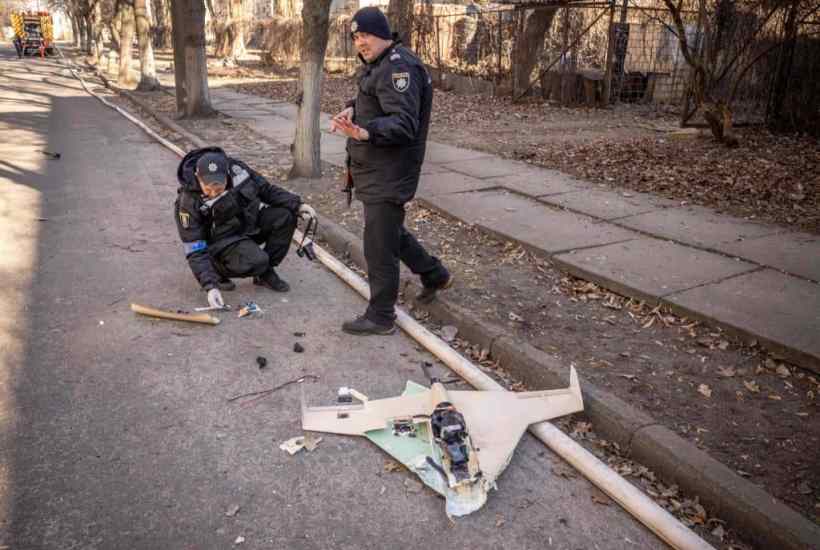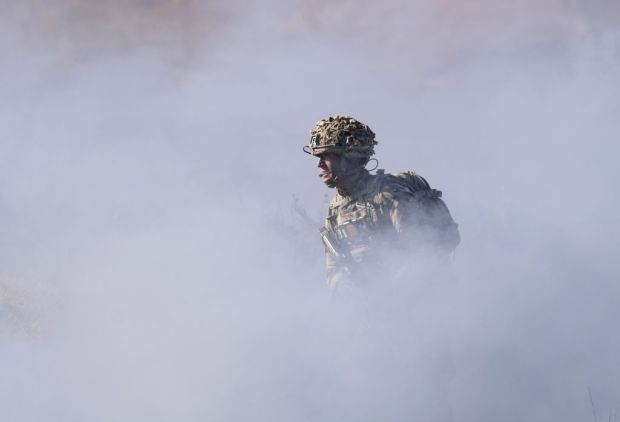‘That used to be my neighbour’s Skoda,’ says Alexei Marchenko, as he points to a twisted lump of metal in the wreckage of a row of garages. We’re standing in the courtyards of his housing estate in Kyiv, where a Russian missile landed overnight. One person has been killed and another dozen injured, although it’s a miracle it wasn’t many more. As well as demolishing several flats, and shattering every window in a half-mile radius, the blast has destroyed the garages-cum-mansheds where Mr Marchenko and his neighbours used to potter. Anyone who’d been there when the missile landed would have been caught up in a cloud of manshed-shrapnel: fragments of Skoda, nuts and bolts, power tools and beer bottles. Luckily, the missile landed overnight when most folk were still asleep. The shelling of residential areas is now commonplace in Kyiv, turning every one of the city’s Soviet-era housing blocks into a potential Grenfell. Yet it’s still a far cry from cities like Mariupol, where entire districts have been razed. Ukrainian officials don’t suggest this strategy is deliberate; it’s just careless and callous.
‘Out of every four missiles the Russians launch, one hits its target, one is shot down by our anti-aircraft defences, and the other two land in random civilian areas,’ a government adviser tells me. ‘I can’t even say they’re doing it on purpose – they just have poor aim.’
At a Red Cross medical tent near another bombed-out high-rise block, there is a remarkable tale of survival. A pet tortoise is recovering, after being hurled from an upper floor window by the blast. The creature landed 50 yards away on a football pitch, where someone handed it in to the Red Cross team’s resident pet expert, Leanna, who’s also looking after six dogs, a hamster, and several cats. The tortoise got away with just a cut to its paw, she tells me.

As a reporter for the animal-loving British press, I have to curb my enthusiasm. We are, after all, covering a story where the human suffering is foremost. Yet Ukrainians are as pet-barmy as Britons are, if not more. Many of the images from the conflict feature refugees clutching cat carriers or pet dogs wrapped up in rugs. Ukrainian public information campaigns talk about how Putin is killing ‘your country, your people, your children and your pets’. Even the Ukrainian novelist Andrey Kurkov, who I interviewed last week, gives Twitter updates on how his cat Pepin is coping during the crisis. It contrasts with Britain’s airlift of dog and cats from Kabul last year, which made it seem like Her Majesty’s Government cared more about animals than it did about Afghans. Ukrainians, it seems, wear their animal sentimentality as a badge of pride. A country that can still look after its pets is a country that can still cope.
After years of reporting on wars in booze-free parts of the Middle East, I did hope that one consolation of covering Ukraine’s conflict was that it wouldn’t be a ‘dry war’. Ukrainians, like many Slavic peoples, enjoy a tipple, so I arrived fully prepared for lots of vodka and cognac toasts in the name of journalistic research. Alas, alcohol sales were banned here in Kyiv in the first week of war, and at my flat, we are running low on supplies. Already we are dipping into our emergency ration, a bottle of semi-sweet liqueur gifted to us by an old lady we met. It reminds me of the stuff some of my elderly aunties used to drink, some kind of Ukrainian Dubonnet. At this rate, we’ll end up drinking perfume, like the Russian army did during WWII.
Ukraine’s equivalent of the Highways Agency appears to have its own wartime pysops wing. All around Kyiv’s outskirts, motorway direction signs have been altered to tell the Russian army where to go, so to speak. One, near the eastern suburb of Brovary, reads: ‘Ahead; go fuck yourself. Left: go fuck yourself again. Right: Russia is this way, fuck off back there.’

It’s another morale booster, although one local Orthodox priest I met did object to the ‘language of the Devil’ being used. He even put some up some roadsigns of his own, urging both sides to think carefully about the cost of the war. They were thoughtful, well-intentioned, and I fear, not widely heeded. He’ll probably get snapped up by Thought for the Day.
While we are at a military funeral on Kyiv’s outskirts, a mobile anti-aircraft unit opens fire about a mile away. They fire a quick burst, streaming missiles into the sky, then drive off to hide before the Russians can locate them. I don’t make much of it, until the next day, when we wake up to learn that a Russian missile has destroyed a shopping mall near the cemetery. At first, it seems like just another bit of ‘careless’ Russian shelling. Later, though, the Kremlin releases a drone video which suggests the shopping centre was being used as a base for mobile rocket launchers. The video shows one such rocket launcher firing into the sky, and then hiding in the mall. A Russian missile then turns the building into a fireball. Unlike some Kremlin videos, there is no reason to doubt this one: the footage is adorned with infographics that geolocate the buildings, timings etc. I can’t be sure the rocket launcher in the video is the one we saw firing, but it’s unnerving proof of how the Kremlin can watch over every inch of the city. It also raises the ethical question of whether the Ukrainians should be hiding weaponry in residential areas. Although as a government spokesman reminds me, it’s Russia who turned Kyiv into a combat zone, not Ukraine.

A pub has reopened in Kyiv, despite the city-wide booze ban. It’s a cellar bar, quite discreet, and as the sole watering hole in town, has the air of a Prohibition-era speakeasy. Quite sure how the bar owner gets away with it, I’m not sure. But nobody is asking too many questions – especially Kyiv’s foreign press corps, of whom there are hundreds, if not thousands, in town. Gone are the days when war zones were just covered by the BBC, Reuters and a few newspapers. Here in Kyiv, I’ve come across all manner of new outfits on the war zone beat. There’s an entire hotel full of Turkish hacks, for example, several crews from Arab channels, a man from Chilean telly who wears leather trousers, and a big booming Indian TV anchor who sounds like Delhi’s answer to John Simpson (he’s rather good actually). I haven’t seen anyone from Russia Today though.
A day mooching round the villages on Kyiv’s western outskirts. This is where the Russians first attacked the capital a month ago, although their advance has since stalled, and Ukrainian forces are now pushing back. It’s quite a prosperous commuter belt area: think Epsom or Sevenoaks as war zones. The problem is that the frontlines keep shifting around, and there is no telling when you might drive down some country lane into a Russian checkpoint, as happened to two freelance colleagues a few weeks ago (they were detained for five minutes, had their passports checked, and politely told to turn around)
Anyone who runs into Russians in a less benign mood, however, is unlikely to escape intact. This, after all, is not one of those wars where the belligerents are insurgent amateurs who can’t shoot straight. Several journalists have been killed around western Kyiv already, so we stay well behind the frontlines. This also has the advantage of being where soldiers feel more relaxed and talkative. One unit tell us how they took a Russian soldier prisoner after he sneaked into no-mans-land to take a dump. It was, you might say, a successful rearguard action. And symbolic, perhaps, of how just much the Russians have been caught unawares by Ukraine’s fightback.
Got something to add? Join the discussion and comment below.
Get 10 issues for just $10
Subscribe to The Spectator Australia today for the next 10 magazine issues, plus full online access, for just $10.



















Comments
Don't miss out
Join the conversation with other Spectator Australia readers. Subscribe to leave a comment.
SUBSCRIBEAlready a subscriber? Log in